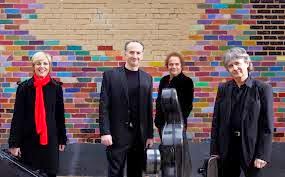Putting its interpretive heritage to work, Takacs Quartet presents 3 Bartok quartets for Ensemble Music finale
 |
| Takacs Quartet made a return visit to focus on Bela Bartok. |
The six string quartets of Bela Bartok are certainly representative of that truth for the early 20th century. They have outlived their time, of course, to become among the permanent glories of the repertoire.
Wednesday night at the Indiana History Center, the Takacs Quartet played three of them. The concert was the season finale of the Ensemble Music Society, whose services to classical music in Indianapolis are unique and enduring. The quartet, now in residence at the University of Colorado, was formed in Budapest in 1975; two original members remain, second violinist Karoly Schranz and cellist Andras Fejer.
Bartok (1881-1945) emerged from the shadow of late Romanticism, with an early overlay of Debussyan impressionism, to forge an original kind of modernism. His aesthetic took rhythmic, melodic and harmonic cues from the Magyar folk music in which the Hungarian was steeped by both affinity and avocation.
First violinist Edward Dusinberre provided concise, enlightening program notes from the stage during the first half, supplementing Marianne W. Tobias' worthwhile contributions to the booklet. He made the connection between Bartok's times and his artistic decisions explicit, especially with respect to Quartet No. 6 (1939), a product of gloomy personal and political circumstances.
The Takacs' performance of Bartok's final piece for two violins, viola, and cello put in high profile the synthesis the composer achieved between the slow, sad introduction of each movement and its distinct character. By the finale, the "mesto" (sad) indication governs everything, with total ensemble commitment to developing the reigning mood and the material used to express it. In contrast to what precedes it, the last movement's chaste use of string sonorities, relieved only by a late, electrifying tremolo shudder sul ponticello, received a poised demonstration in this performance.
In the earlier movements, the sad music was outlined spellbindingly by violist Geraldine Walther (first movement), Fejer (second movement), and Dusinberre (third movement). Of the main sections, the droll vigor imparted to the "Burletta: Moderato" stood out for its blend of control and wild abandon.
The concert opened with a performance of Quartet No. 2 (1915-17), with Debussyan colors marking the first movement in particular. The second movement brings out the rough and playful side of the composer; those aspects are strenuous and dissonant in early Bartok. By the time of the late Concerto for Orchestra, the rough playfulness had been smoothed out, but remained characteristic. The Takacs tore into that movement in a way that offered maximum contrast with the "Lento" finale, music that seemed to offer something sustaining to cling to.
Quartet No. 4 (1928) brought the concert up to intermission. The brutal first movement sounded emotionally detached, which struck me as apt, considering the work's emergence in modernism's heyday. I wouldn't fault any of the interpretive decisions behind this persuasive reading.
The sinister, elfin quality of the second movement balanced its more insouciant companion movement: the fourth — all pizzicato with a wry ending. The aching tension evident in Fejer's performance of the third-movement cello melody was carried throughout, making of this centerpiece an emotional fulcrum on which the whole balanced.
The feeling of satisfying completeness after the three works were so well performed meant that no encore was offered — or expected, despite the loud, jubilant ovation, which indicated the audience felt sufficiently rewarded.



Comments
Post a Comment